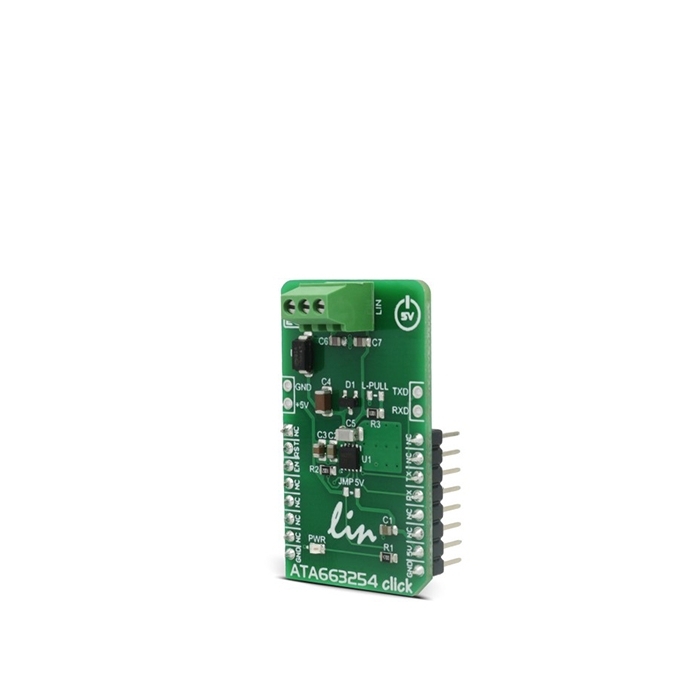MIKROE ATA663254 Click
MIKROE ATA663254 Click is a fully integrated LIN transceiver device with an integrated 5V LDO voltage regulator.
Product Overview
MIKROE ATA663254 Click is a fully integrated LIN transceiver device with an integrated 5V LDO voltage regulator. The combination of voltage regulator and bus transceiver makes it possible to develop simple but powerful peripheral nodes in LIN bus systems. The integrated LDO can be used to provide power to the host MCU so that no additional voltage regulators are required, only the power supply connected to the LIN connector is needed. ATA663254 click features the undervoltage protection, short-circuit protection, TXD time-out timer and its LIN physical layer complies with LIN 2.0, 2.1, 2.2, 2.2A and SAEJ2602-2 standard specifications.
These features make ATA663254 Click a perfect solution for realizing small and portable LIN based networks that are commonly used in automotive applications for communicating with the vehicle sensor peripherals, but also for any application where robust and interference-free communication up to 20Kbps is needed.
LIN (Local Interconnect Network) is a serial network protocol used for communication between components in vehicles. LIN networks are cheaper than CAN networks and since the LIN network can have up to 15 peripheral nodes, it is often used as a subnetwork of CAN.
ATA663254 Click uses the ATA663254 integrated LIN bus transceiver with the 5V voltage regulator from Microchip. The ATA663254 communicates with the MCU by using the UART RX and TX signals. Besides for communication, these pins also serve to signal the failsafe condition. The failsafe condition can be caused by the undervoltage on the LIN connector: less than 3.9V will cause the undervoltage condition, signaled by the LOW logic state on RX pin and HIGH logic state on the TX pin. A wake-up event from either silent or sleep mode is signaled by the LOW logic state on both of the RX and TX pins. This event is being received via the LIN bus and it is used to switch the ATA663254 click to an active state. RX and TX signals are also routed to the header on the edge of the click board™ so they can be used independently of the mikroBUS™ socket.
The NRES pin of the ATA663254 IC is routed to the RST pin on the mikroBUS™. RST pin is used to signal the undervoltage condition on the LDO regulator section. When the LDO voltage falls under the predefined threshold, the RST pin will be set to a LOW logic state, signaling this condition to the MCU. The LDO output is routed to a header located on the edge of the click so that the LDO can be used independently of the mikroBUS™ socket. Also, there is an SMD jumper that can be shorted if powering up the MCU via the mikroBUS™ 5V pin is required, on a custom board design. Note that the MikroElektronika development systems are not meant to be powered up by the mikroBUS™ power supply pins, so the ATA663254 click comes without the SMD jumper, by default.
The EN pin is used to enable the functionality of the device. When the EN pin is set to a HIGH logic level, the device is set to work in the normal mode, with the transmission paths from TXD to LIN and from LIN to RXD both active. When the EN pin is set to a LOW state, the device is put into silent mode, depending on the TX pin state. The EN pin has a pull-down resistor, so it is pulled to Ground if it is left afloat.
Besides the 5V LDO output header and the external UART header, the Click is equipped with the three pole connector for an easy and secure connection to the LIN network and the 12V battery power supply.
Note: The JMP 5V SMD jumper should not be populated if used with MikroElektronika development systems. It is reserved for powering up the custom-made systems via the 5V connector
Features & Specs
- Interface: GPIO, UART
- Compatibility: mikroBUS™
- Dimensions: 42.9 x 25.4mm
- Input Voltage: 5V
- LIN Operating Voltage Range: Min. 5V, Typ. 13.5V, Max. 28V
- Integrated LDO Output Current: 85mA
- Integrated LDO Output Voltage: Min. 4.9V, Max. 5.1V
Documentation
Customer Reviews

Stock and Customer Discounts
Available Discounts
- $15.15 | 25+ units
- $14.36 | 100+ units




